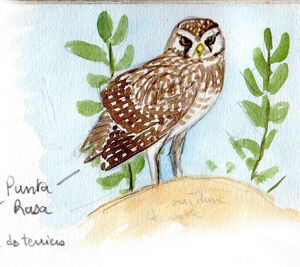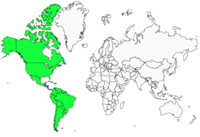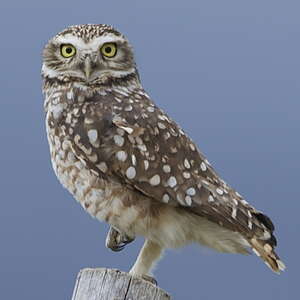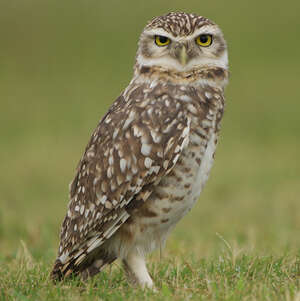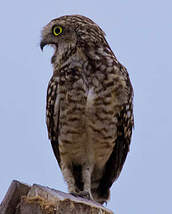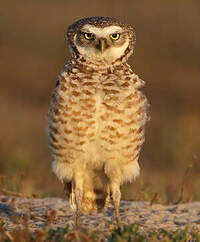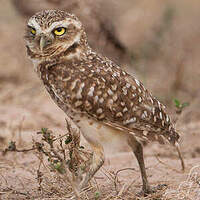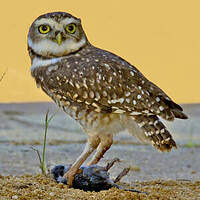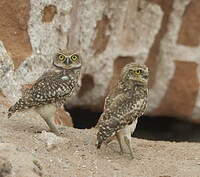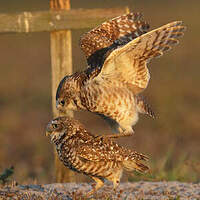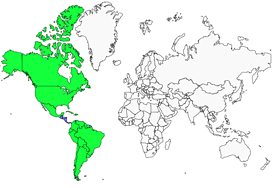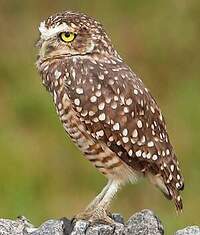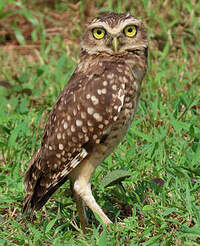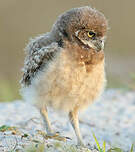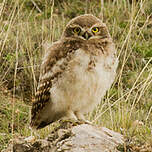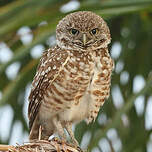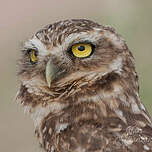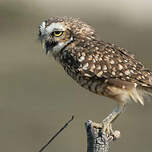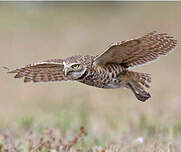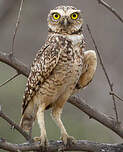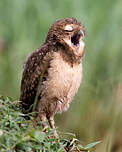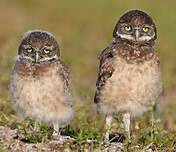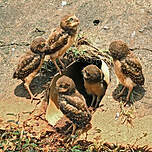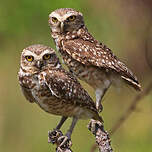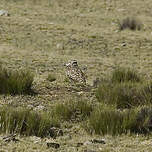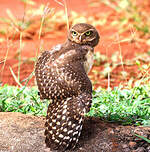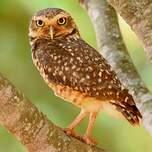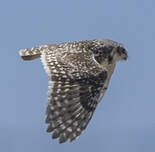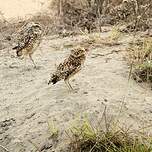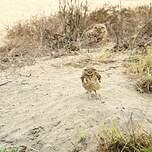Burrowing Owl
Athene cunicularia - Chevêche des terriers
Identification
Burrowing Owls have everything to attract us. Their European and Indian cousins just have more poetic names: the Athene's Owl and the Indian God Brahma's Owl. Our owl measures from 20 to 25 cm, has a round head with two white facial disks that encircle two very large black eyes framed by yellow. The beak is light grey, sometimes slightly yellowish, with grey wax. Under the facial disks, a black collar separates the throat from the chest as it ascends up to the eyes. The eyebrows are white and very marked, the brown forehead striped with white points and lines. The main color of this strigidae is a variable grayish brown, largely spotted with white, depending on individuals and subspecies (19 !). All the wing coverts, the remiges, will therefore present a mottled white, as well as the back and the cloak. The short brown rectrices are horizontally striped, the bird showing little of its tail. The throat is white, while the chest is gray-brown, always with the presence of characteristic white spots, the belly is also white striped with horizontal brown marks. The legs are long, the Burrowing Owl stands on its legs high, the tarsi are slightly feathered.
The female is slightly larger and more striped on the belly than the male which has lighter brown coloration, difficult to distinguish from its partner. The young are less marked and spotted with white on the back, the belly is whitish and does not show horizontal brown stripes.
The Burrowing Owl has a territory so wide that size and coloration can vary according to subspecies; North American individuals are generally larger than their subtropical cousins.
Subspecific information 18 subspecies
- Athene cunicularia cunicularia (s Bolivia, Paraguay and s Brazil to Tierra del Fuego)
- Athene cunicularia hypugaea (sw Canada to w Mexico)
- Athene cunicularia rostrata (Clarion I.. off w Mexico.)
- Athene cunicularia floridana (c and s Florida. USA. , Bahama Is.)
- Athene cunicularia amaura (Antigua, Nevis. Lesser Antilles.)
- Athene cunicularia guadeloupensis (Guadeloupe. Lesser Antilles.)
- Athene cunicularia guantanamensis (Cuba)
- Athene cunicularia troglodytes (Hispaniola, Gonâve and Beata Is.)
- Athene cunicularia brachyptera (wc, nc Venezuela, Margarita I.. off n Venezuela. and Aruba (Netherlands Antilles))
- Athene cunicularia minor (c se Venezuela, s Guyana, n Brazil)
- Athene cunicularia carrikeri (e Colombia)
- Athene cunicularia tolimae (w Colombia)
- Athene cunicularia pichinchae (w Ecuador)
- Athene cunicularia nanodes (sw Ecuador to sw Peru and n Chile)
- Athene cunicularia juninensis (sc Peru to w Bolivia and nw Argentina)
- Athene cunicularia boliviana (Bolivia)
- Athene cunicularia grallaria (e and c Brazil)
- Athene cunicularia partridgei (Corrientes Prov.. n Argentina.)
Foreign names
- Chevêche des terriers,
- Mochuelo de madriguera,
- coruja-buraqueira,
- Kaninchenkauz,
- üregi bagoly,
- Holenuil,
- Civetta delle tane,
- prärieuggla,
- Graveugle,
- kuvik zemný,
- sýček králičí,
- Prærieugle,
- preeriapöllö,
- mussol de lloriguera,
- pójdźka ziemna,
- racējapogs,
- Кроличий сыч,
- アナホリフクロウ,
- 穴小鸮,
- 穴鴞,
Voice song and cries
Habitat
Behaviour character trait
Little information is known about migration, North American individuals and those from Southern Canada appear to migrate south into the USA. Other populations and subspecies are resident. Often seen on the ground, or perched at medium heights, near their burrows, the Burrowing Owl is frequently observed nesting in its den.
Dietfeeding habits
The Burrowing Owl has an extensive range and its diet is varied: arthropods in general, insects, spiders, scorpions, small mammals, amphibians, small reptiles like lizards. It also hunts other birds, particularly various kinds of Columbidae. Although classified as a nocturnal raptor, the Burrowing Owl hunts during the day as well as the twilight although it prefers to hunt then.
Reproduction nesting
The Burrowing Owl is monogamous, but can become polygamous. The couple will nest in burrows which they can dig themselves or use the burrows of other animals, such as prairie dogs, marmots, rats, and armadillos.
The breeding season lasts from March to August. The male will court the female with head rubs in an imprinting ritual as well as a nuptial flight; he will also bring her prey. Six to twelve eggs will be incubated by the female for about thirty days; the male will hunt for her during the entire incubation. The young leave the burrow after fifteen days, and start to fly after forty-four days; the parents will feed the chicks, who remain near to the burrow. The parents will put droppings, often taken from around herds of cows, near the entrance to the burrow in order to attract insects and thus feed their offspring.Geographic range
Threats - protection
IUCN conservation status
concern
in the Wild
threatened
evaluated
The Burrowing Owl's situation is quite paradoxical, it seems to be expanding in South and Central America, where its all-terrain regime allows its expansion. In contrast, it has gone to the endangered species status in Iowa and Minnesota, and several other American states like Oregon and California have classified the Burrowing Owl as a species with special attention. In Canada, in British Columbia and Alberta, it has been classified as endangered. The reasons are largely extensive agriculture that destroys burrows, pesticides, and human population expansion. Our Little Owl is thus victim of many car accidents, hunting, poaching, ingesting prey contaminated by pesticides, its nesting way makes it a prey for dogs and cats, not to mention its natural enemies like other raptors, or snakes that attack its burrows. Decisions such as the banning of pesticides within a 250m radius around the Burrowing Owl nesting sites have recently been made in Canada. In Florida, education programs have been launched : will it be enough for preserving the raptor that we all love to see?
Sources of information
- IOC World Bird List (v14.1), Gill, F and D Donsker (Eds). 2024-04-18.
- A Field Guide to the Birds of Brazil, Ber Van Perlo
- Vol. 5 - Handbook of the Birds of the World, Josep del Hoyo-Andrew Elliott-Jordi sargatal
- ARKive, Christopher Parsons
- BirdLife International, BirdLife International
- The Owl Pages, Deane P.Lewis
- Wikipédia, Wikipedia, The Free Encyclopedia
Other sources of interest
 Specification sheet created on
29/07/2023 by Anne et Gabriel Leboff
Specification sheet created on
29/07/2023 by Anne et Gabriel LeboffTranslation by AI Oiseaux.net
published: 28-04-2013 - Updated: 28-12-2016
© 1996-2024 Oiseaux.net
- Accipitriformes
- Aegotheliformes
- Anseriformes
- Apodiformes
- Apterygiformes
- Bucerotiformes
- Caprimulgiformes
- Cariamiformes
- Casuariiformes
- Charadriiformes
- Ciconiiformes
- Coliiformes
- Columbiformes
- Coraciiformes
- Cuculiformes
- Eurypygiformes
- Falconiformes
- Galliformes
- Gaviiformes
- Gruiformes
- Leptosomiformes
- Mesitornithiformes
- Musophagiformes
- Nyctibiiformes
- Opisthocomiformes
- Otidiformes
- Passeriformes
- Pelecaniformes
- Phaethontiformes
- Phoenicopteriformes
- Piciformes
- Podargiformes
- Podicipediformes
- Procellariiformes
- Psittaciformes
- Pterocliformes
- Rheiformes
- Sphenisciformes
- Steatornithiformes
- Strigiformes
- Struthioniformes
- Suliformes
- Tinamiformes
- Trogoniformes

